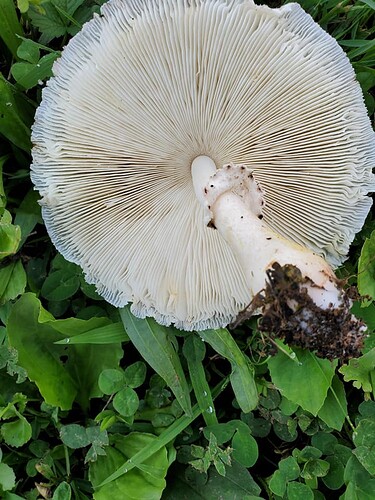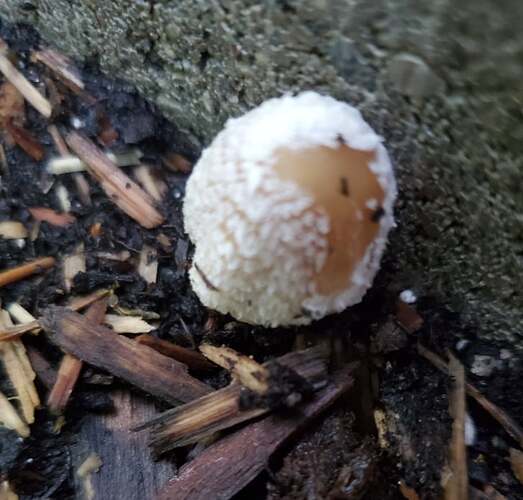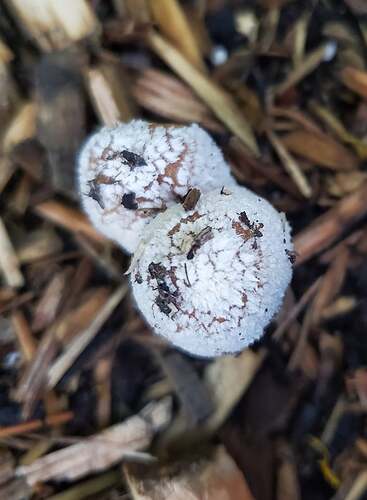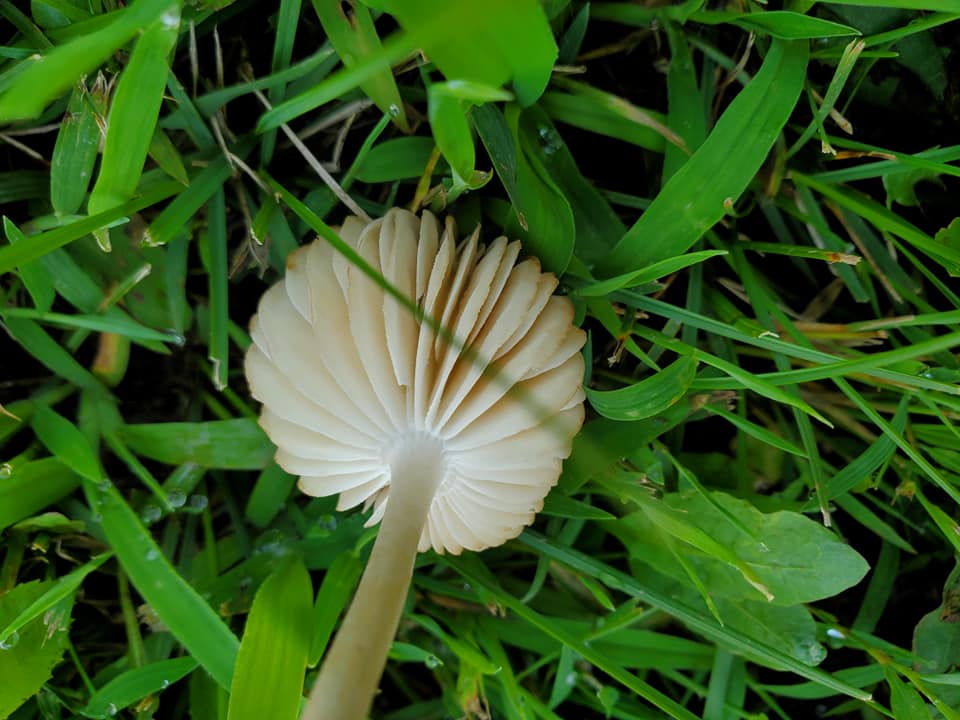I was downloading several apps and even posted on several pages and groups on Facebook to identify different mushrooms to no avail. I was hoping that someone here would or could tell me where I could go to get mushroom identification. We have been getting tons of mushrooms on our property this year when we rarely do. There are several different ones, but 3 are most prevalent. I know there are plant ID apps, but they don’t do mushrooms. Mushroom ID apps aren’t giving me the right answers as I Google them afterwards because the pictures don’t match. It’s really frustrating to find source material for the identification of mushrooms. I have books on the ID of various plants and trees of Illinois, but none of them covers mushrooms. I am well and truly at a loss. Any help would be much appreciated. Just in case someone in here knows, these are the three most common ones that show up since I have pictures already. They’re taken from Decatur, IL, early morning, on a rotted out tree stump.
I don’t know that mushroom, unfortunately, but there are lots of mushroom ID groups. I would suggest picking up a few mycology guides for your state. Identification is best a combination of visual features, smell, looking at what it grows on, and also doing a spore print. Even if you learn 4-6 mushrooms a year, soon you’ll know plenty! Best of luck 
Thank you Dana … just wasn’t sure if there were any sources/resources we had for mycology. I am a part of a couple of those groups, but posting hasn’t had any answers come forth. Apps neither, but I will see if I can find a book or something for this region. I don’t see any other options at this point. We know the top one had one that was partially eaten, so something things it’s ok lol I only picked the ones that I needed for ID as people need to see the underside and the stem, as well as size. They are amazing fungi … very tolerant of the hot sun here aparently lol
My husband has spent literally decades learning mushrooms, and there are no shortcuts. Get a couple of good ID guides, not a computer app, and just put in the time to learn them.
Many animals can eat things that aren’t safe for us (especially bugs and slugs, lol), so it’s no indication of edibility if part of a 'shroom is eaten. The top one… I feel like I should know it, but I’m a slacker because my hubby always IDs everything I find. The 2nd one is probably an amanita, and the next fuzzy photo might be the same kind. Mushrooms can be attacked by molds too. The last one my husband would probably know, but I’d call it an LBM: little brown mushroom, small, hard to ID, and fairly likely to be poisonous, or, in other words, not worth messing with if you’re looking for edibles. It’s an old specimen too.
You might check out any local mushroom clubs in your area. There are mycological clubs and societies all over the country. (I belong to a couple here in the northeast.)
The first looks like it could be in the Lepiota genus, but that’s still a LOT of possibilities.
And I definitely also suggest local mycology clubs and a print field guide (or two) for your region. Looking at comparison pictures and descriptions, that you can then run by someone with practical experience, can be a really powerful combination for learning.
The first one looks like one that we call a destroying angel. If that is the one it’s highly toxic. We had to watch out for it when I used to gather puff ball mushrooms. When they first come up they look similar until the ring around the stem breaks and the top opens up
Thank you @fisherkm @willowm and @Darkunderling2 for your advice. I didn’t find a group local and would have to travel over an hour to get to one, which not having a car presents its difficulties lol I am looking for field guides, but tried local first to no avail, so I figure I will get a general field guide for the Midwest and see how well that works. Evidently, there are classes local from time to time, but since Covid-19, they have suspended them and might start them back up next year. Regardless, I will keep trying to find ways to learn more about mushrooms seeing as how I keep getting lots of them. There are even more pictures from within a couple of blocks of where I’m at. They’re all so unique and some are very pretty. I don’t know why there aren’t more mycologists.
INaturalist is a pretty awesome app especially if you can get good photos! It’s backed by National Geographic and the American Academy of Sciences I believe. It’s what I use. Also your local library should have books on your local mushrooms.
I have iNaturalist already to use whenever I have a BioBlitz. We are always sending in pictures and information to contribute to it. I haven’t gotten results that were concrete on the app when trying to identify for some reason. I have the same problem with other applications and even Google Image search. It is probably something I am not doing right. Still, I have found a couple of groups with promise and learned how to at least tell if a mushroom is edible even without identification, so that helps. It’s nice to see someone else uses iNaturalist though. For the longest time, I didn’t think anyone had ever heard of it in this area lol Thank you for your advice, I appreciate it. I definitely want to start getting better at mushroom identification since we have an abundance of them here in our yard/garden. I haven’t been to the library, but they had it closed for over a year due to Covid-19. They are open again, but I have issues with masks and you cannot get in unless you’re wearing a mask and are vaccinated. I am vaccinated, but PTSD and some other issues make it impossible for me to wear a mask longer than a couple of minutes. Though, now that I think about it, I might be able to research books and then call and have them set them aside so I can pick them up quickly. I just forgot about that option. Thanks again!
Sorry if I misunderstand, but there is no way to do this. There are no particular signs of edibility or inedibility. This is really important because quite common mushrooms can be deadly. I don’t know if someone is telling you BS or if I’m not clear on what you mean by “edible without identification.”
I’ve never used iNaturalist, as I’m just not a high-tech type and my "smart"phone is way too stupid for that to function. I’ve heard that bird and flower ID apps don’t seem to work very well. Mushrooms are so very complex, and people often take poor photos because they don’t know what needs to be included. Sometimes you need spore prints or serious microscope work just to know what you’ve got. To get serious about identifying edibles, learn how to take a spore print. Any decent mushroom ID guide should include that.
I meant it in general, not a sure-fire way. I was given a list of things to look for, including spore prints to give me a general guide as to ones to avoid, like ones with red caps and white gills. I was taught a bit about spore prints and what they could mean. They taught me things like breaking off a small piece and smelling it and it should smell fresh or like a fresh mushroom, but if it has any other kind of rotten or acrid smell, it’s most likely poisonous. They instructed to break open some to see if there were gills on the inside that couldn’t be seen, and a few other tips and tricks. I’m not eating any of the mushrooms, though I would love to, but with the complexity of mushroom identification and not having any field guides that make sense or have pictures that actually look like what I have and confusing data and aspects of the mushrooms will exist in two different species and spore print didn’t give the right answers either, so I wanted to be sure to get the poisonous ones out of the yard. Even if it’s not 100%, it’s still better than not having any idea. If mycologists have been known to get it wrong at times, I’m sure there’s always going to be issues with identification. I just meant in the general sense. We have kids that play in the yard behind us and they’ve been known to pick things and eat them, even when I’ve tried to tell them not to without us there to say what is and isn’t edible. We grow so much stuff they assume because it’s all edible to us that the whole plant is edible. I just don’t want them picking mushrooms that could harm them. After a bit of trying to do things the way they said, I still wasn’t sure, so I removed them all. I don’t like doing that, but I have to protect the kiddies. I will try to find a local group and join them and learn more about mushrooms, but until a group forms or is close enough to join (all closed down within reach because of the pandemic and is all digital, which doesn’t seem to help much). I forgot to come back to say what all happened lol
Hi,
I’ll add my two cents, in case it helps.
I pick mushrooms every fall, but having been born in a city i also started from scratch like you. i’ts easier than it seems, but it takes time.
My advice, as the others have said, will be to get a good book, that covers ONLY your area.
Also, if you can get some field experience with someone who knows a bit about mushrooms, that will boost your learning and will make learning from a book easier.
Then every year, as you learn to identify the diferent families of mushrooms you will know that there are entire families wich are completely safe (like russulas) and others very dangerous (like amanitas).
One last advice: Smelling mushrooms is useful for sorting out unpalatable ones, but it is not enough to discard toxicity.
Thank you for your advice. I have been looking for someone local, but have yet to find anyone, or anyone that is willing to do any fieldwork. I am sure in time that will change, at least I hope so. I also hope that they will make it a lot easier when using a book, because I cannot find any books on mushrooms for only this place. I think Midwest books were as narrowed down as I was able to find. I know there are online guides for Illinois, but not books to carry with me.
Yes, they taught me about the smell, also about taste too. I was extremely surprised to find out that there are those who use a small portion of a mushroom to taste and eat to see if there is any gastric issues with it so they know if it’s edible. I would have thought it was a bad idea to do that lol
I plan on doing whatever I can to learn more, just might have to wait for Covid-19 protocols to go away first. Everything has been cancelled everywhere around here because of it.
Also, we find mushrooms in spring and in summer in our yard, but rarely in the fall. Now, if we head out to the parks, we can find them all spring, summer, and fall. We end up with mushrooms in our yard that typically grow in full summer sun, which surprised me. When you say starting from scratch, I would say I’m an absolute beginner and I don’t mean the song lol I’m so novice at this that books seem impossible to use as guides. There is so much there it is hard to decipher, but I am sure I will find someone soon.
Thanks again for the advice.
Perhaps not a particularly useful comment here, but I remember when I first walked into the PNW forest here I couldn’t identify any plants. I certainly wouldn’t try to eat anything. It all just seemed like “plants”. Some plants had pokey leaves. Some had round leaves. Some were toxic. Some were edible, but they all looked like plants to me.
After spending hours and hours and years and years hiking, sitting, drawing, and observing, I now can identify most plants found in the PNW forest. I know what’s edible and not. I don’t remember really studying exactly to figure them out, just observing mostly, and eventually beginning to recognize similarities and differences.
I’m also learning mushrooms, and I’m realizing that if I get hung up on identification, too cerebral, I get overwhelmed and terrified of their potentially toxic nature. What if I make a mistake! Mushrooms are highly complex beings, and they are calling to me as important at this time. I have to remember my Druidic roots, if you will, to listen to them in the same way that the plants talk.
It’s kind of like walking into a room full of strangers and seeing a bunch of faces vs. walking into a group of friends or family members. You certainly wouldn’t mistake your Aunt Betty for Uncle Tim, but in a room full of strangers, perhaps you might mistake or misremember.
Anyway, as I’m learning mycology, I feel better realizing that there was a time I didn’t know a huckleberry from a salal. LOL. This lets me just observe, be at peace, and listen with that Awen spirit that Druids are so famous for. In the meantime, I found a great site yesterday called Cascadia mushrooms and I’m gonna experiment with the more edible and known varieties that way. For now, I’m only on an observation basis in the wild world.
Hubby recommended a couple of field guides. “Midwest” is close enough. You don’t need a guide specifically for Illinois.
Mushrooms of the Upper Midwest: A Simple Guide to Common Mushrooms, by Teresa Marrone and Kathy Yerich
Mushrooms of Northeastern North America
by Alan E. Bessette and Arleen Rainis Bessette (but I can tell you this one is pretty big and technical)
Mushrooms of the Northeastern United States and Eastern Canada: Timber Press Field Guide by Timothy J. Baroni
Do not taste just any mushroom. Tasting can be useful if you already know what general group the mushroom belongs to, such as a russula or a bolete, none of which are deadly poisonous. But taste in general is NO INDICATION of whether a mushroom is poisonous. Some amanitas are actually good edibles; some are deadly, many are sickeners. The deadly ones don’t necessarily taste bad.
Learning really is a slow process. Before the internet, my husband had already spent decades learning edibles. Some of them are pretty easy to identify–chanterelles, morels, hen of the woods, chicken of the woods, black trumpets, and so on. But those probably aren’t what’s growing in your yard. Even my husband still finds mushrooms in our yard that he can’t identify. Common agaricus (good edible) may grow in a yard–but you absolutely, positively must know how to distinguish it from an amanita.
I would learn to distinguish general groups first–mushrooms that have gills, those that have pores under the cap, polypores that grow on wood, and so on.
I don’t know if this will be helpful at your stage, but hubby also suggested a website where newbies can post photos and get them identified: wildmushroomhunting.org .
You have to join; free membership, not commercial. He’s one of the main identifiers there. You need to take good photos that show various features–top and underside of the cap, stem, habitat where it’s growing. Dig down and get the whole stem as the base may have important features.
@MelanieT Unfortunately, there are no forests close to me. There are small batches of wooded areas, but the nearest forest is at least a couple of hours away. I am surrounded by corn, soy, or sorghum fields here. Mushrooms weren’t too plentiful until the last couple of years. My father taught me identification of most plants and trees when I was young, but even he didn’t mess with mushrooms, other than to buy and cook. I was so fortunate to have a family that lived close to nature and taught me a lot.
I listen to plants and my friends think I’m nuts. I haven’t tried in the sense of getting to know mushrooms in that way, and I love how you worded it and I will give it a try. Thank you very much for your suggestion. I appreciate the thoughtfulness.
@fisherkm Please tell your husband thank you and I thank you for asking him about books that would be helpful. It isn’t easy when you’re trying to figure this out on your own for the time being. I am beginning to see how learning about mushrooms can be a lengthy process. What grows in our yard is several different types and sometimes they’re all right next to each other. We had a mushroom growing on top of another mushroom. I mean they were different types growing on top of each other. It was the weirdest sight to see.
I had tried to do the photo ID thing and the problem is that when I see the mushroom, the apps never send me back pictures that are even remotely close to the descriptions they have. It’s so odd. I rarely have luck with those apps. It’s the same with plant identification when I was in an area that I wasn’t familiar with. Turns out, according to the Master Gardener at the university an hour away knew what it was and was impressed as she said it usually doesn’t grow this far north. It’s called Crinum. They have beautiful flowers and I found it in the wild, but she said they are normally zoned for 9 - 11 and I’m in 5, so you see it’s odd that it was growing. It’s a lily I guess, at least it looks like one. I wanted to bring some home but thought better of it once I found out that they don’t usually grow here, so something right in that spot was perfect for them.
Anyway, got off on a tangent lol I will look up and get those books. I am going to try to find a class somewhere near here too. It isn’t easy finding classes, but I am sure they have to have them somewhere near here.I appreciate your ideas and your husband’s references. It is so great and awesome to have so many people that are so helpful and supportive.
Wildmushroomhunting.org isn’t an app. It’s a website where you can post photos you’ve taken with your phone or camera or whatever. A human being will look at the photos and try to identify the 'shrooms. (And if it’s my hubby… it may be more than you wanted to know!)
Ahhhhhhh ok @fisherkm I get you now lol I will go there and perhaps post some pictures lol I used to have a lot of pictures of mushrooms I found walking in Ireland up in the woodlands in Donegal and they were amazing. I know I had found at least 30 different kinds of mushrooms growing on a path leading up a very large hill. It was an amazing view from the top, but the mushrooms made that walk even more amazing. It was like a magical fairy world up there. The colors of the mushrooms were so vibrant and the shapes were so unusual. I had a pretty crappy camera at the time and no phone at all, so the pictures weren’t great for identifying them and I didn’t take any of them for inspection later, but still wish I had those pictures. Some mushrooms are just so cool looking.
Out of curiosity: is mushroom picking traditional in your area?
I ask because here in Catalonia we’re i live, is kind of a National sport. Catalans are mushroom geeks, people here get deep in the woods just to reach that special place where some valuable mushroom grow.
There are many people in the states who love their mushrooms. More or less, most of the people I know are farming them now. Still, I hear the occasional person where I live say they’re going to hunt a particular mushroom, like morels. I live in an area that doesn’t seem to get as many mushrooms as other parts of the country, or even this state does. Last year and this one has seen a huge increase, but I am assuming it is because the weather has been cooler, more overcast, and much more rain than in previous years. Still, it’s a pretty big thing in the states, I just happen to live in a place that doesn’t have many people who love nature like most of us in here do. I live in a very pro-fracking, oil drilling, petroleum-based product kind of area. I live in an area that, quite literally, despises my kind. I have a few close friends who agree with my choices in life, but they keep it quiet. We have actually seen people attacked here for being nature-minded. Go a few hours in any direction and you will notice a huge difference in opinions though. But, having said that, it’s not the areas that agree with me that I need to live in … it is the areas that need the most change. Hopefully, I can get other people interested in nature and even mushrooms. It’s a newfound thing for me since I am seeing them pop up everywhere. I like to know about my surroundings. 





